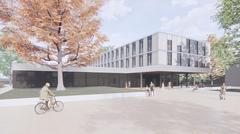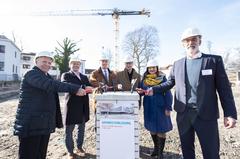URL: https://www.desy.de/news/news_search/index_eng.html
Breadcrumb Navigation
DESY News: Groundbreaking for Science Data Management Centre for gamma-ray astronomy
News
News from the DESY research centre
Groundbreaking for Science Data Management Centre for gamma-ray astronomy
The Science Data Management Centre (SDMC) of the international gamma-ray observatory, the Cherenkov Telescope Array Observatory (CTAO), will soon be located in Zeuthen in the German federal state of Brandenburg. Brandenburg´s Science Minister Manja Schüle and Volkmar Dietz, Head of the Sub-Department Large Facilities and Basic Research at the Federal Ministry of Education and Research, together with Federico Ferrini, Managing Director of the CTAO gGmbH, and DESY Director Helmut Dosch, today laid the foundation stone for the SDMC of the astroparticle physics research infrastructure CTAO.

A look into the future: The DESY campus in Zeuthen with the SDMC building. Picture: Heinle, Wischer und Partner | Freie Architekten
Manja Schüle, Minister of Research of the State of Brandenburg, says: “DESY scientists have been involved in major international research projects in astroparticle physics for decades. The decision to locate the Science Data Management Centre of the international gamma-ray observatory CTAO in Zeuthen greatly enhances this research location in the state of Brandenburg, which is internationally established with researchers from more than 30 nations and has regional roots at the same time. Soon, not only will enormous amounts of data be processed and coordinated there. There will also be rooms for lectures, training and - more important than ever - for meetings. I am convinced that science and research will continue to bring people together in the future. But since Russia's war of aggression on Ukraine, trusting institutional cooperation with Russian and Belarusian institutions is no longer possible. That is why we support DESY's decision to suspend all scientific cooperation with Russia and Belarus. Science and research build bridges - but these must be built by both sides. In the face of this war in Europe, there must not and cannot be a simple 'business as usual'. We are fully on the side of the peace- and freedom-loving people in Ukraine - and of all scientists who have spoken out against the war. I am certain that the new Science Data Management Centre will be a jewel in the Brandenburg research landscape - and build new bridges.”

Groundgreaking ceremony for the new Science Data Management Centre of the Cherenkov Telescope Array Observatory at the DESY campus in Zeuthen. From left to right: CTAO managing director Prof. Federico Ferrini, Dr. Volkmar Dietz, Head of Large-scale Facilities and Basic Research Sub-division in the Federal Ministry of Research, DESY director Prof. Helmut Dosch, Helmholtz president Prof. Otmar Wiestler, Brandenburg's science minister Dr. Manja Schüle and DESY director for astroparticle physics Prof. Christian Stegmann, also head of DESY's Zeuthen campus. Credit: DESY, Marco Urban
“With the new CTAO Science Data Management Centre, DESY in Zeuthen is taking another big step towards becoming an international centre for astroparticle physics in Germany and one of the most innovative research centres in the region,” says Helmut Dosch, Chairman of the DESY Board of Directors.
“DESY operates one of the world's largest research groups for gamma-ray astronomy in Zeuthen. With the SDMC, we are further strengthening this expertise and will host many external scientists from this field. This will significantly impact our campus for the next decades,” explains Christian Stegmann, DESY Director for Astroparticle Physics and head of the DESY site in Zeuthen.
DESY in Zeuthen is already now one of the largest scientific institutions in Brandenburg with approximately 280 employees. The construction of the SDMC will create about 60 additional jobs. In addition, more guest scientists will visit the institute in the future. Up to 400 people will then be working on the campus.
Federico Ferrini, Managing Director of the CTA Observatory gGmbH, says: “The CTA Observatory is a truly international project. At its two sites in Chile and La Palma, it will generate large amounts of valuable data to be analysed by the growing worldwide community of astrophysicists and particle physicists. It is great to see the Science Data Management Centre building up here in Zeuthen as one of the crucial ingredients for the success of CTAO.”
The CTAO SDMC
Tens of Petabytes (PB) of simulated as well as processed data gathered at both CTAO telescope sites will be generated, further processed and accessible at the SDMC.The CTAO Computing Department located at the SDMC will be in charge of designing and implementing software systems that support science activities from accepting observation proposals to scheduling observations, controlling the telescopes, processing and archiving the data at all levels, and disseminating data products and science tools to the public using open standards and FAIR (findability, accessibility, interoperability, and reusability) principles.Thus, in the SDMC, CTAO staff are dedicated to the topics of scientific data processing, software development and maintenance, user support & training, service operation (science data management), data quality control, and electronic helpdesk. The work in data processing and software development requires possibilities for highly concentrated work as well as spontaneous or targeted communication for scientific exchange and knowledge transfer. The new SDMC building, located directly at Lake Zeuthen, will provide approximately 1200 square metres of usable space in a flat base building and a cantilevered office block above. Approximately 500 square metres are also planned for a new canteen, which will cater for the increasing number of future employees on campus.
The building is being financed as part of an institutional grant to the Helmholtz research centre DESY with federal funds of around 9.9 million euros and funds from the state of Brandenburg amounting to 1.1 million euros. The SDMC building is to be certified with a Silver rating under the Sustainable Building Rating System. Construction work began at the end of 2021, and move-in is scheduled for 2023.
Background information CTAO
The Cherenkov Telescope Array Observatory (CTAO; www.cta-observatory.org) will be the first ground-based gamma-ray observatory and the world’s largest and most sensitive instrument for the detection of high-energy gamma rays. The CTAO’s unparalleled accuracy and unprecedented energy range (20 GeV- 300 TeV; GeV=Giga electron volts; TeV= Tera electron volts) will provide novel insights into the most extreme and powerful events in the Universe, addressing questions in and beyond astrophysics falling under three major themes: Understanding the origin and role of relativistic cosmic particles, probing extreme environments (such as the vicinity of black holes) and exploring frontiers in physics (including the study of Dark Matter). To do so, CTAO has two telescope array sites: One in the Northern hemisphere in La Palma, Spain, and one in the Southern hemisphere in the Atacama Desert, Chile. The headquarters of the CTAO is hosted by Italy at the National Institute for Astrophysics (INAF) in Bologna, and the Science Data Management Centre (SDMC) is hosted by Germany at Deutsches Elektronen-Synchrotron (DESY) in Zeuthen. CTAO will also be the first of its kind to be open to the world-wide astronomical and astroparticle physics communities as a resource for data from unique, high-energy astronomical observations.
The preparation of the design and implementation of the CTAO is managed by the interim legal entity CTAO gGmbH (CTAO gGmbH) until the final legal entity is achieved, the CTAO ERIC (European Research Infrastructure Consortium) in charge of the construction and operation of the Observatory. The CTAO gGmbH is governed by the CTAO Council, composed of shareholders from 11 countries and one intergovernmental organisation (ESO), as well as associate members from two countries. The CTAO gGmbH works in close cooperation with the CTA Consortium (CTAC), a group of more than 1500 scientists and engineers working from 25 countries that contribute to the definition of the instrument design and the scientific programme.



